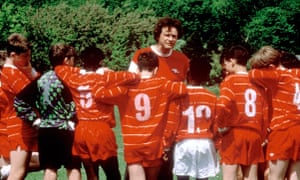For the past 30 years the Sports Book of the Year has brought joy, sometimes bewilderment, and quite often a spike in sales as it forced a neglected genre to raise its game

T
here was a time, a generation or so ago, when high street bookshops were a wasteland for sportswriting. The entire subject was usually relegated to a single shelf in a dusty corner, with slabs of the Rothmans Football Yearbook or the Wisden Cricketers’ Almanack manspreading next to turgid autobiographies and regurgitated annuals. Those who wanted to learn chess, bridge or squash were well catered for. Everyone else, not so much.
But then came the William Hill Sports Book of the Year award, which will name its 30th winner on Tuesday, and suddenly everything became more electric – and eclectic.
From the start it cleverly played fast and loose with what constituted a sports book, encouraging publishers and eventually bookshops to take risks and expand their horizons. No wonder winners since have ranged from WHSmith crowdpleasers (It’s Not About the Bike, Seabiscuit) and instant classics (Rough Ride, Dark Trade, A Life Too Short) to an Oxford poet’s account of learning aikido with the Japanese riot police (Angry White Pyjamas).
How has it got away with being so bold and diverse? Much of it was because two of Fleet Street’s greatest – the Daily Mail’s Ian Wooldridge and the Observer’s Hugh McIlvanney – were on the judging panel from the off, conferring it instant legitimacy. Each year both men would arrive at the judges’ lunch or dinner armed with different books, like gunslingers at the end of a Clint Eastwood western, according to Graham Sharpe, who co-founded the award with John Gaustad of Sportspages.
There was then an eerie silence before the other judges started lining up behind one or the other, although differences were always settled – eventually – after fierce debates and several bottles of plonk. “There are never regrets or grudges held,” insists Sharpe. “It is like boxing. People smash each other up but in the end they always embrace.”
More often than not the judges have got it right. Sometimes, however, their decisions are so perplexing you wonder whether their drinks were spiked with extra-strength absinthe. In 1999 A Social History of English Cricket somehow emerged triumphant ahead of Joe McGinniss’s The Miracle of Castel di Sangro and David Remnick’s King of the World – a work as dazzling as its subject Muhammad Ali’s hand speed. No wonder the estimable Frank Keating wondered on these pages whether “the judges had such a donnybrook that the conservative outsider was the only one they could ‘agree to disagree’ on”.
However, its stock continued to grow particularly when the size of the “William Hill award effect” became apparent. One publisher mentioned a book that had sold 20,000 before the award in late November put on another 30,000 before Christmas after its victory. Another said he would tell wavering sales directors that a potential book had a chance of being a William Hill contender, which often led to it being snapped up. It helped too that the first winner, True Blue: The Oxford Boat Race Mutiny, and the fourth, Fever Pitch, became films.
Of course Nick Hornby’s fanography did far more than just that. As Keating put it on these pages, Fever Pitch’s victory created a “whole new liturgy for the literati … suddenly it was compulsory for every city’s ‘top end Hampstead’ intellectuals to gather around dinner tables and talk with rapt studiousness, not about Pinter, Amis or Truffaut, but Robson and Seaman and Gazza.”
William Hill award has done so much to help sports writing leap off the page
![William Hill award has done so much to help sports writing leap off the page]() Reviewed by audrinadaniels
on
November 26, 2018
Rating:
Reviewed by audrinadaniels
on
November 26, 2018
Rating:


No comments: